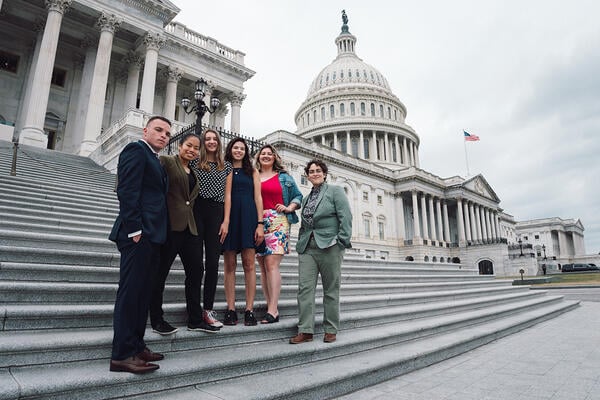
How Will Latest ED Layoffs Affect Students With Disabilities?
The Office of Special Education and Rehabilitative Services, which focuses on ensuring equal opportunity and improving outcomes for individuals with disabilities in the public education system, was among those hardest hit by mass layoffs at the Education Department on Oct. 10. And while most of the media focus has been on how the cuts to OSERS impact the K–12 sector, advocates for those with disabilities say members of the higher ed community will also be affected.

“It’s fair to say that OSERS was gutted,” said Jacqueline Rodriguez, CEO of the National Center for Learning Disabilities. “What we’ve understood is that now only two people remain at the Office of Special Education Programs, and very few people, if any, remain in Rehabilitative Services Administration. So there is no one in place in the federal government that will ensure kids with disabilities receive the education that they’re entitled to.”
Historically, the graduation gap between students with disabilities and students without has been much higher at colleges and universities than high schools. For example, in 2022 the national high school graduation rate for differently abled students was 74 percent, compared to 87 percent over all. Meanwhile, the six-year graduation rate for differently abled students in bachelor’s degree programs was 49.5 percent, compared to almost 68 percent for students without disabilities.
The difference may stem largely from the fact that unlike eligible K–12 students, who are guaranteed access to an Individualized Education Program under the education-specific Individuals with Disabilities Education Act, college students are only protected by the broader Americans with Disabilities Act and Section 504 of the 1973 Rehabilitation Act. That means they have to advocate for themselves and go through complex bureaucratic processes to obtain accommodations, and the quality of those accommodations can vary broadly from college to college. (A handful of states have passed legislation requiring colleges to consider a student’s high school IEP when deciding what accommodations to provide, but even then, services are not guaranteed as they are under IDEA.)

Jacqueline Rodriguez
National Center for Learning Disabilities
Such challenges will only get harder to tackle without nonpartisan ED staffers to hold colleges accountable to the few regulations that do exist, Rodriguez said. Without the same contact points, students and advocacy groups may no longer have a place to go when questions arise.
Inside Higher Ed asked Rodriguez five questions to get a better understanding of what the future will look like for students with disabilities in higher ed.
Responses have been edited for length and clarity.
- What do the cuts to OSERS mean operationally? What programs and services will be able to continue?
The general public doesn’t realize all the components that OSERS supports. It ranges from the individual student’s education all the way up to the support that states receive, the Parent Technical Assistance Centers and the Regional Education Laboratories that were conducting research, as well as technical assistance for states, universities and K–12 schools. It was a very broad, very valuable component.
But even more acute is going to be the impact that individual caregivers, families and the students themselves will feel, because OSERS, as well as the Office for Civil Rights, were responsible for upholding the law for students. What we’ve been hearing across the country is that families of kids with disabilities have elevated their concerns—whether it’s discrimination, bullying, harassment, seclusion or restraint—to the Office for Civil Rights, [but] because of their reduction in force, they are not even being involved in the investigatory process. They’re being told that it’s been resolved. Sometimes parents aren’t even getting a response from OCR due to the lack of capacity.
The impact is not in the abstract. There are recent historical examples of what happens when states are left to their own regard to interpret the law: They are consistently interpreting it inaccurately, and they have required the department, and specifically OSERS, to come in and provide guidance.
- Is there an example of these challenges specific to higher education that you think we will see play out?
Often, going into a postsecondary educational environment, students receive vocational rehabilitative service dollars that would support that transition [and] career planning, as well as in some cases even textbooks and curricular work. Without the department’s oversight, distributing those funds becomes very concerning, and then consideration of how those funds can be appropriately used for what purposes and to whom is in question.
Finally, the way in which we are able to advocate for either increased funds or better guardrails and guidance is by the data that is collected through the department. We don’t have great data at the university level on how many students are identified with disabilities, because [current laws] don’t include that as part of their factor. So we have to essentially extrapolate from K–12 data that if 13 to 15 percent of kids with disabilities are receiving service under IDEA, it’s likely that the same amount should also be receiving similar services on a college campus. Without that data, there’s no mechanism to advocate for additional funding to support those same students.
- When people suggest that most of the effect of these layoffs will be limited to K–12 education, what do you tell them?
Part of IDEA’s mandatory functions is Part D, which is to prepare personnel to serve students with disabilities. Congress and the public understood that special educators must and should be required to be specialized in servicing and educating kids who learn and think differently.
But these grants were decimated a couple of months ago, and the administration has removed any capacity for future special educators to actually be experts in the space in which they educate students because they are not professionally providing that same level of funding towards institutions of higher ed prepare them.
I was a recipient of Part D funds, and it would have been impossible for me to attain my Ph.D. at the University of Central Florida without the support of [Office of Special Education Programs] funds, and in turn, I worked at the College of William & Mary on the faculty in the School of Education, not simply preparing teachers who would be special education–focused, but I prepared general education teachers, related service providers and law school students who were going to be working in school districts to, again, ensure that families’ rights were upheld.
So without that funding at the master’s and doctorate level, there are fewer educators who are fully prepared to meet the needs of these students in our classrooms. Education degrees cost as much as a business degree but do not have the same return on the investment. And so fewer people can pay out of pocket for these degrees, and fewer people go into the profession when it’s not being supported.
- Many of OSERS’ functions are statutorily mandated, and the Trump administration is talking about shifting those responsibilities to another agency. What would be the detriment of having these programs transferred?
The administration dangled in front of Congress and the public their intention to move OSERS functions, and in particular, the statutory requirements through IDEA, over to another agency, Health and Human Services. What they received was incredible pushback from both the public and from Congress, because serving students with disabilities is, as we have put it, bipartisan. Nobody has politicized kids with disabilities more than this administration.
What you’ve seen recently is that this administration told the public that the RIFs were due to the government shutdown, but because of the litigation, the government has had to show their cards, and that is not at all the case. The RIFS were actually preplanned. They were structured and strategic.
So when the administration then tells the public if we move OSERS’ functions to another agency you shouldn’t worry because those agencies are fully prepared, the public should question the mere premise of that statement. If the administration is willing to outrightly lie about the RIFs being associated with the government shutdown, then the public should question if moving it could actually be successful.
- Will there be longer-term consequences not just to academics but also to things like workforce development as a result of these cuts, and if so, what will they be?
I think the short answer is yes, we will see those consequences. But if you can allow me the liberty, I’ll address your question in a way that someone else asked me recently, which was, how long will it take for us to see the impact of the destruction, and how long will it take for us to rebuild this for kids who have disabilities?
And the group of advocates that I was sitting with at the time all agreed. We’re talking a minimum of one generation if not more, because the impact medium and long range on these students will be about how we create an inclusive workforce climate. How do HR systems consider disability as a part of the genetic variation that every human has? And how do we accommodate people so that they can thrive?
It’s going to be impactful when we see a generation of students who don’t actually get the services that they are legally entitled to and then do not go into the same industries they may have gone into because they were not provided the education they needed in the manner in which they learn. I really cannot emphasize enough how kids are going to bear the ultimate burden of these decisions, and their life outcomes will shift in this generation because of the decisions the administration is making.
Source link



